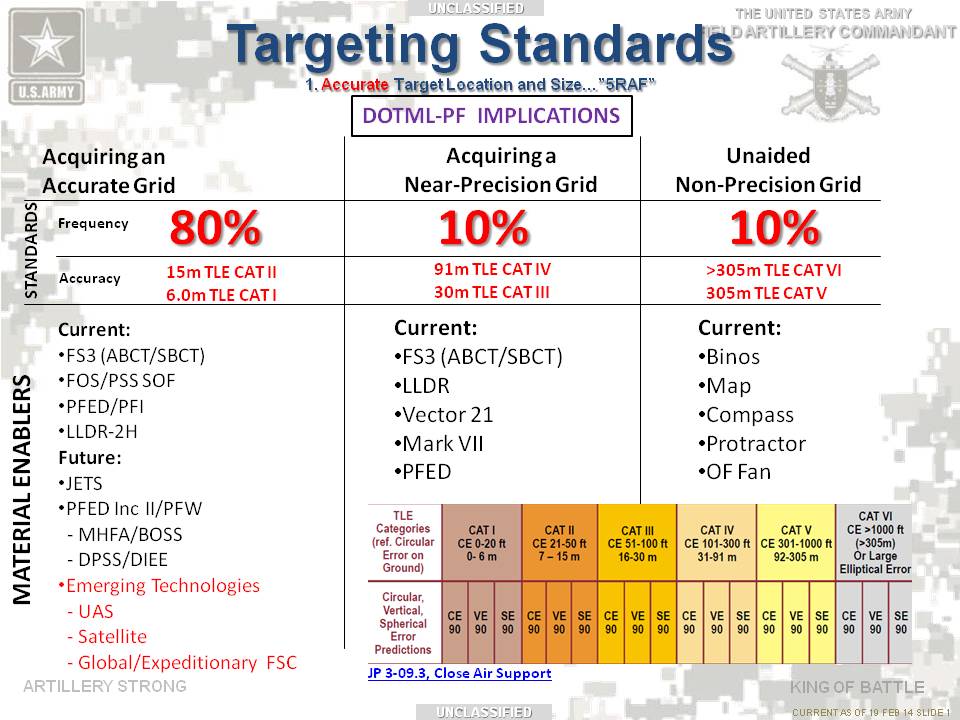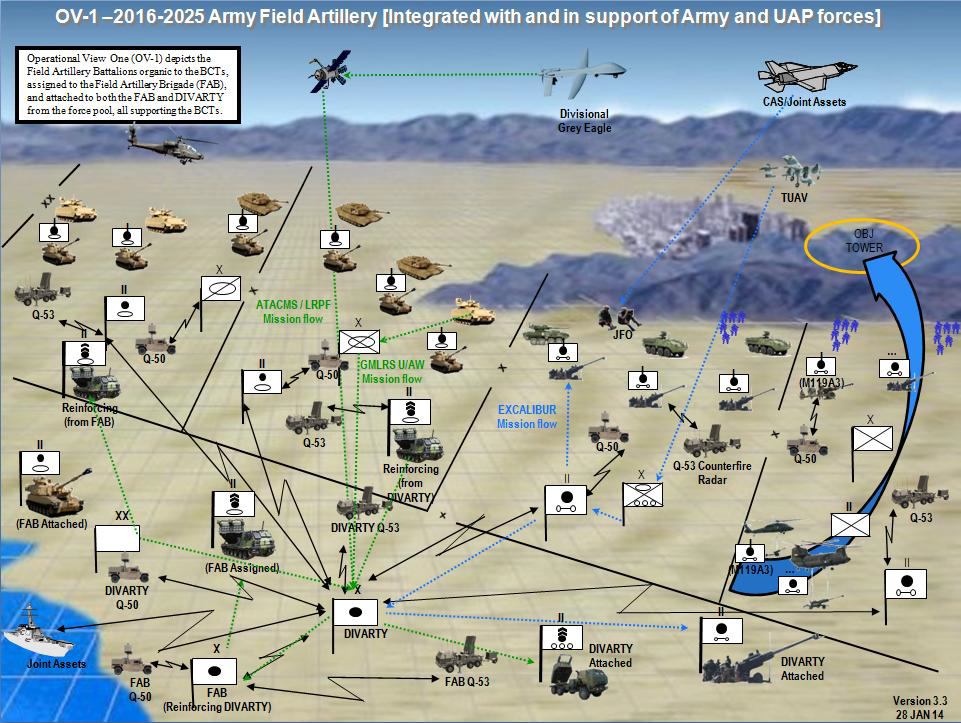In December 2012, the Fires Center of Excellence (FCoE) submitted an FDU (Fires HQ FDU) to re-establish Fires command headquarters at echelons above brigade (EAB), for consideration in the Total Army Analysis (TAA) process for FY16-20. On Oct. 3, 2013, the Vice Chief of Staff of the United States Army approved the Fires HQ FDU. The first DIVARTY will be fully operational in July 2014 with the 1AD. It is anticipated that this organizational design became completed across the force by the first quarter of FY16.
Implementation of DIVARTYs
The U.S. Army forces Command (FORSCOM) division Artillery (DIVARTY) Implementation Order provides clear guidance on the implementation and the role of DIVARTYs. To read the full order log on to FKN with a CAC card @ https://www.us.army.mil/suite/doc/42594219
The Army decision to implement DIVARTYs will provide Field Artillery (FA) capabilities (planning, synchronization, and coordination) in order to execute strategic, operational and tactical Fires in support of Unified Land Operations (ULO) and to provide effective mission command for the training and readiness of attached FA units. Current Echelon Above brigade (EAB) mission command FA force structure and organizational design does not sufficiently meet the required capabilities in support of combatant commander (CCDR) requirements as part of the joint force. This results in the inability to effectively integrate and synchronize Fires at division, corps and theater Army in support of ULO.
The DIVARTY is a proven force design that will play a key role in reversing the continuing atrophy of FA skills, halt the erosion of professional and leader development in the Fires warfighting function, and restore the art and science of synchronizing effects for precise and discriminating Fires.
80:10:10

Precision targeting is non-negotiable. So, going forward we are implementing an 80:10:10 or a ‘Grid Getter Standard.’ 80:10:10 is a ratio based on a precision mindset that makes it necessary for Forward Observers and fire support teams to achieve joint TLE categories while on the battlefield. Specifically, achieving a CAT I (6.0 meter TLE) and CAT II (15 meter TLE) ‘precision grid’ 80 percent of the time; achieve a CAT IV (50 meterTLE) ‘near precision grid’ 10 percent of the time; achieve a CAT V/VI (200 meter or greater TLE) as a degraded operation, the final 10 percent of the time. This 80:10:10 ratio defines for us as professional Artillerymen the term accurate in the first requirement for accurate Fires. It also defines for us, as a profession of arms, how we train, certify and deliver accurate target locations in support of strategic, operational and tactical Fires.
Due to the complexities of the operational environment, the requirements for precise and discriminating Fires, as well as the restrictions on employment of Fires, these demands require that Fires organizations and fire supporters be thoroughly trained and certified. The Field Artillery headquarters facilitates standardized core training throughout the fire support chain by ensuring routine training as a complete fire support systems, significantly enhancing the maneuver's commanders ability to plan, integrate, task organize, and execute Fires in support of ULO.
DIVARTY will provide operational-level Fires and better trained Fires formations BY, WITH, and THROUGH the brigade combat team and the modular force.
Combat Power Enhanced BCT
The Fires HQ FDU establishing the DIVARTYs and Field Artillery brigades is just one critical element of a larger initiative to modernize Field Artillery Fires based on lessons learned from more than twelve years of conflict. Supporting initiatives include; re-assignment of fire support personnel, currently assigned to the BCT maneuver battalions, back into the FA cannon battalions to better enable focused organizational training and certification programs and provide flexible employment of fire supporters to achieve the BCT commanders Intent for Fires; Precision Gunnery POI implementation across the entire 13-series institutional training base that emphasizes use of precision technology enablers to achieve 80:10:10 targeting standards; precision enhanced CFFT III training that delivers high-quality technology injecting and immersing learners in collaborative practical and problem solving exercises that are relevant to their fire support environment and enhances competencies, such as initiative, critical thinking, teamwork, and technical accountability; implementing ALM 2015 initiatives such as, “Context-based, collaborative, problem-centered instruction,” that integrates the learner-centered, experiential methodology. All of these initiatives, combined with subject matter expertise residents within the Fires HQ FDU construct and the flexibility of DIVARTYs to provide Reinforcing and joint Fires will dramatically improve the lethality of the Maneuver formation from Squad to EAC.
Operational-Level Fires
As we go forward, it will remain a requirement for us to provide operational-level Fires. To quote TRADOC Pam 525-3-4, The United States Army Functional Concept for Fires, we have a responsibility to establish and maintain a fire support system that can, “enable the defeat of a wide range of threats, provide timely and responsive Fires in environmental and operational conditions, provide a range of precision to conventional scalable capabilities to engage ground targets, prevent fratricide and minimize collateral damage, and to provide access to and integrate joint, Army, and multinational Fires capabilities at the lowest appropriate levels.” We are aggressively addressing this requirement for operational-level Fires and have proposed that operational Fires should be conducted as a part of the commander’s operational design. This will allow the commander to achieve his desired effects on the enemy in a manner that does not require detailed integration with the scheme of subordinate maneuver elements.
Operational-level Fires is the transition from the Theater joint force Air Component Command fight to air-ground integration fight. operational-level Fires are usually conducted at the operational level of war, but may be conducted at any level of war. Operational-level Fires generally integrate Army Field Artillery (surface-to-surface) Fires with joint and multi-national capabilities but could be conducted by any combination of available Fires assets. Field Artillery brigades and DIVARTYs focus on the conduct of operational-level Fires, including the integration of sensors and intelligence assets to support the targeting process, although they can also conduct close-support Fires that require detailed integration with the scheme of subordinate maneuver elements. Close-support Fires are usually planned, coordinated, integrated, synchronized and conducted by BCT Field Artillery battalions.
For additional understanding on what the new DIVARTYs will bring to the force, the United States Army Field Artillery School has put together some “facts on the Fires HQ FDU.”
Fires HQ FDU FACTS:
The Fires HQ FDU creates a DIVARTY for each active component division and will align an active component Field Artillery brigade (FAB) to each corps and one to Eighth United States Army (EUSA). The term ‘Fires brigade’ (FiB) is being replaced with Field Artillery brigade (FAB). The FDU does not alter the organization of the Army National Guard (ARNG) FABs; however ARNG FABs will be aligned with ARNG divisions for training affiliation and will be capable of serving as a DIVARTY to support ARNG divisions during deployment and provide reinforcing and counterfire capability to a corps or joint task force (JTF). The primary task for the FAB includes coordination, integration, synchronization and employment of Fires as well as provides long-range precision Fires to the corps through strike operations.
This may also include the coordination of joint and Multinational Fires. Initially, the active FABs will be composed of rocket battalions. The number and mix of FA battalions assigned to a FAB will vary depending on mission and number and type of divisions assigned to the corps. The FAB consists of a brigade support battalion, an HHB, a signal company, and a target acquisition platoon (TAP). The FAB will train with and achieve the same regional focus as its assigned corps. The FAB does not replace the corps fire support cell. The FABs subordinate FA battalions may be allocated/task organized to DIVARTYs or other FABs. This will be accomplished using command and support relationships, such as reinforcing (R), to provide enhanced fire support capability. The FAB is the force Field Artillery (FFA) headquarters for the corps. The FAB commander is the corps fire support coordinator (FSCOORD).
For DIVARTY the primary tasks include coordination, integration, synchronization and employment of Fires to achieve the division commander’s objectives. This also includes the coordination for joint and or Multinational Fires. The DIVARTY will have no organic firing units, but can be provided a variety of FA battalions (rocket and cannon) and other assets to accomplish its mission for the division commander. This may include a combination of one to five rocket/missile (MLRS or HIMARS) and/or FA cannon battalions as well as other enablers. The DIVARTY consists of a headquarters (HHB), a Signal Platoon, and a target acquisition platoon (TAP), initially consisting of two AN/TPQ-37 Radars and over the next six years transitioning to two AN/TPQ-53 Radars. DIVARTYs will provide command oversight for training management and certification of the brigade combat team (BCT) FA battalions, and fire support Cells. DIVARTYs will provide synchronization of sensors such as Sentinel and counterfire radars organic to the division as well as synchronization of joint sensors. This sensor integration capability significantly strengthens the division’s ability to support information collection and targeting for the division and brigade combat teams throughout the depth of the operational environment. The DIVARTY will also function as the force Fires headquarters for the division. The DIVARTY commander is the division FSCOORD.
For additional understanding, this article also outlines the DIVARTY components from the Indirect Fires Capability Portfolio Review.
Indirect Fires Capability Portfolio Review

The Fires Concept from the Indirect Fires Capability Portfolio Review (IDF CPR) is an effective view of the capability DIVARTYs bring to the BCT. DIVARTY will be set to synchronize and integrate divisional- and joint-level sensors, shooters, amplifying Fires lethality capabilities provided to BCTs through their dedicated Field Artillery battalions.
Conclusion
As we implement this Fires HQ FDU, it will not be a repeat of the 2004 DIVARTY. We are not merely pulling and implementing DIVARTY doctrine from days gone by, dusting it off and calling it good. The DIVARTYs will provide modernized relevance through focused implementation of emerging Fires technologies and expert integration of joint and combined Fires. BCTs will be empowered by enhanced Fires capabilities delivered by precision fire supporters with world-class training and certification, precision equipment and leaders adept in the art of Fires and mission command. This embedded Fires capability amplified by Reinforcing and joint sensors management and Fires provides the Army with Fires that meet the requirements within the full spectrum of ULO. The Fires Center of Excellence encourages open dialogue as we build our DIVARTYs and fire support teams to maintain our position as the King of Battle! Go to this link on FKN to read the DIVARTY White Paper in its entirety@ https://www.us.army.mil/suite/doc/42414285